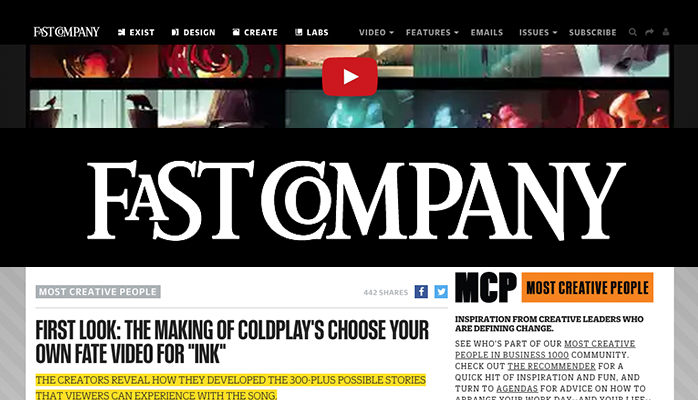How To Get Published In Fast Company
I was recently published in Fast Company, who I follow for the latest trends in technology, design, and business. I’m a die-hard fan, and it has always been a goal of mine to get featured in it.
After completing a huge project for Coldplay, I knew I had something buzz-worthy to share, and that it absolutely had to be featured in Fast Company. But I had no clue on where to start nor any connections to anyone there.
Around the same time, I was doing a phone call interview with freelance writer, Alex Huls, for a separate topic. At the end of the call, I expressed my desire to get into Fast Company, and sought his advice. What he told me was incredibly invaluable (thank you Alex), and became the roadmap to help me figure this all out.
I’m no PR expert, but here are the 4 steps I took to make it happen.
1. Research, and make sure your content is appropriate and relevant.
Not all content is appropriate for every single publication or blog. The editors are very picky about what they post – that’s what makes them great. Take an objective look at the content you’re trying to push out, and make sure the subject matter reflects the publication/channel.
My project for Coldplay involved design, technology, and it doesn’t hurt that they’re also an amazing band. All of these subjects I knew were covered by Fast Company.
2. Find the right editor or writer.
Go to the website of where you want to get published, and check out the articles that have covered similar topics. I looked for articles on interactive videos, design, and music. Check out who published the articles, and review their body of work. Are they consistently covering the space you’re in? If the answer is yes, then it’s more likely that they’ll connect with you and your content.
Luckily professionals these days have some sort of online presence, so I knew with a little research, I would be able to find a way to contact these folks and work my way in. I found a good handful of them on LinkedIn and Twitter, some of which had their email listed on their profile. For those that weren’t listed, I used some tips I learned previously with Rapporative. Now I was able to directly contact and pitch my content to the writers and editors of Fast Company.
3. Pitching your content.
Before you go off reaching out, make sure you have your pitch intact or you probably won’t get through. As I’m told, writers and editors get pitched hundreds of ideas every morning, so get to point right away and make their job easy.
My email pitch went like this:
Hello ______,
I recently directed and produced Coldplay’s “Ink” – an interactive animated experience, here at Blind. I’m a subscriber and huge fan of Fast Company!
I’m reaching out to you and your team to see if you’d be interested in featuring an article with exclusive BTS content from “Ink” that shows exactly how it was created from it’s inception.
I know you’ve done quite a bit of coverage of music and culture at Billboard and Rolling Stone, and I feel like this article might be right in your wheelhouse.
I’ve attached a link to a sample (PDF) which has some breakdown of the process, as well as a few of the images I have ready for the article. I also have a BTS video pending approval featuring Chris Martin and the design team behind the project.
I’d love to give you guys the exclusive, but if this isn’t quite the right fit for your pub, I’d love and appreciate any recommends you might have for me.
Warm Regards,
Matthew
Here’s a simple breakdown of my email structure:
- What is, and why it’s buzz-worthy
- Why it should matter to them specifically – citing similar work they’ve done in the past
- Make it a no brainer– do as much upfront work for them providing a writeup or press release, and supporting media
- Offer an exclusive on content if possible – this makes the opportunity much sweeter
- If it’s not right, thank them and ask for a recommendation on who to speak to
- Within 20 minutes I found a writer who was interested in covering the story
4. Don’t get discouraged, but strike while the iron is hot.
I did not get through to the first person I emailed, nor the second or third. If your content doesn’t get picked up right away, don’t be discouraged, but act swiftly. There can be a lot of reasons why someone might not respond (too busy, more pressing stories to cover, etc.). Keep researching and reaching out, cause publications are always looking for good content to feature, while it’s relevant.
Make sure to give writers and editors enough time to plan out the release of your story. If you want your article to be released on launch, give at least 2-3 months of lead time (from what I’ve been told), especially if it’s for print.
I truly hope this information is useful to you. Hopefully I’ve inspired more of you get yourselves out there and work towards your goals. And to those on the receiving end, writers and editors, I hope you get better-crafted pitches coming your way, instead of more spam in your inbox.
Disclaimer: These tips are based on my personal experience. I’m not saying this is the only way, or even the right way to do things, but I wanted to share what worked for me. I’d love to hear more suggestions or– especially from writers, editors, and PR experts.
By: Matthew Encina, Creative Director
Follow everywhere @matthewencina
